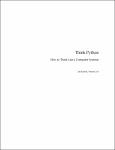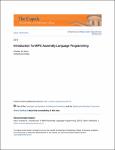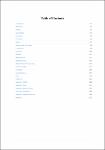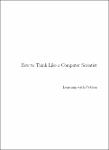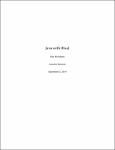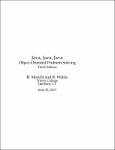Search
Author
- Jorgensen, Ed (2)
- McFadyen, Ron (2)
- B. Downey, Allen (1)
- C H, Swaroop (1)
- next >
Subject
- Java (4)
- Python (3)
- BlueJ (2)
- Computer Science (2)
- next >
Date issued
- 2010 - 2020 (9)
- 2008 - 2009 (1)
Has File(s)
- true (10)
Search Results
"Think Python is a concise introduction to software design using the Python programming language. Intended for people with no programming experience, this book starts with the most basic concepts and gradually adds new material. Some of the ideas students find most challenging, like recursion and object-oriented programming, are divided into a sequence of smaller steps and introduced over the course of several chapters.
This textbook has been used in classes at Bard College, Olin College of Engineering, University of California, Santa Barbara, University of Maine, University of Northern Colorado." |
"This book was written to introduce students to assembly language programming in MIPS. As with all assemblylanguage programming texts, it covers basic operators and instructions, subprogram calling, loading andstoring memory, program control, and the conversion of the assembly language program into machine code.
However this book was not written simply as a book on assembly language programming. The larger purposeof this text is to show how concepts in Higher Level Languages (HLL), such as Java or C/C++, arerepresented in assembly. By showing how program constructs from these HLL map into assembly, theconcepts will be easier to understand and use when the programmer implements programs in languages likeJava or C/C++. Concepts such as references and variables, registers, binary an... |
"A Byte of Python" is a free book on programming using the Python language. It serves as a tutorial or guide to the Python language for a beginner audience. If all you know about computers is how to save text files, then this is the book for you. |
Allen Downey is an American computer scientist, Professor of Computer Science at the Franklin W. Olin College of Engineering and writer of free textbooks. Downey received in 1989 his BS and in 1990 his MA, both in Civil Engineering from the Massachusetts Institute of Technology, and his PhD in Computer Science from the University of California at Berkeley in 1997. He started his career as Research Fellow in the San Diego Supercomputer Center in 1995. In 1997 he became Assistant Professor of Computer Science at Colby College, and in 2000 at Wellesley College. He was Research Fellow at Boston University in 2002 and Professor of Computer Science at the Franklin W. Olin College of Engineering since 2003. In 2009-2010 he was also Visiting Scientist at Google Inc.
Jeffrey Elkner is a h... |
This book is Part II of a two-part set that introduces the Java programming language. The text assumes the student will be using the BlueJ development environment and provides some introductory BlueJ material. Our experience has been that BlueJ is easy to learn and provides a good programming environment for the beginner programmer. |
The purpose of this text is to provide a reference for University level assembly language and systems programming courses. Specifically, this text addresses the x86-64 instruction set for the popular x86-64 class of processors using the Ubuntu 64-bit Operating System (OS). While the provided code and various examples should work under any Linux-based 64-bit OS, they have only been tested under Ubuntu 14.04 LTS (64-bit). The x86-64 is a Complex Instruction Set Computing (CISC) CPU design. This refers to the internal processor design philosophy. CISC processors typically include a wide variety of instructions (sometimes overlapping), varying instructions sizes, and a wide range of addressing modes. The term was retroactively coined in contrast to Reduced Instruction Set Computer (RISC... |
There are a number of excellent, comprehensive, and in-depth texts on MIPS assembly language programming. This is not one of them.The purpose of this text is to provide a simple and free reference for university level programming and architecture units that include a brief section covering MIPS assembly language programming. The text assumes usage of the QtSpim simulator. An appendix is included that covers the download, installation, and basic use of the QtSpim simulator.The scope of this text addresses basic MIPS assembly language programming including instruction set usage, stacks, procedure/function calls, QtSpim simulator system services, multiple dimension arrays, and basic recursion. |
This book is Part I of a two-part set that introduces the Java programming language. The text assumes the student will be using the BlueJ development environment and provides some introductory BlueJ material. Our experience has been that BlueJ is easy to learn and provides a good programming environment for the beginner programmer. |
This open access book offers an initial introduction to programming for scientific and computational applications using the Python programming language. The presentation style is compact and example-based, making it suitable for students and researchers with little or no prior experience in programming.
The book uses relevant examples from mathematics and the natural sciences to present programming as a practical toolbox that can quickly enable readers to write their own programs for data processing and mathematical modeling. These tools include file reading, plotting, simple text analysis, and using NumPy for numerical computations, which are fundamental building blocks of all programs in data science and computational science. At the same time, readers are introduced to the fun... |
"We have designed this third edition of Java, Java, Java to be suitable for a typical Introduction to Computer Science (CS1) course or for a slightly more advanced Java as a Second Language course. This edition retains the “objects first” approach to programming and problem solving that was characteristic of the first two editions. Throughout the text we emphasize careful coverage of Java language features, introductory programming concepts, and object-oriented design principles.
The third edition retains many of the features of the first two editions, including:
Early Introduction of Objects
Emphasis on Object Oriented Design (OOD)
Unified Modeling Language (UML) Diagrams
Self-study Exercises with Answers
Programming, Debugging, and Design Tips.
From the Java Library Sec... |

